Back to page 1
The Essentials
In looking at the features that matter most to the fans — the elements that directly affect their enjoyment of the “game-day experience” — I thought it would be fun to look at what features were left behind at Ray Winder Field, and which ones came across the river with the team to the new park.
First, Travs fans are happy that the cramped concourse — where you couldn’t see the field at all — were left at Ray Winder, because Dickey-Stephens has one of the best concourses in the Minors. Second, the antiquated restrooms –which included troughs in the men’s room — are a thing of the past. Third, the fact that there was no chance you could catch a home-run ball (because there were no seats or concourse beyond the outfield walls) was strictly a Ray Winder phenomenon, since the new place has a wonderful 360-degree concourse. Fourth, you had very little selection at the souvenir stand, because there was simply no room to display much. The store in the new park is both beautiful and well-stocked (as an aside, I read that the Travs sold about $75,000 worth of souvenirs during the entire 2006 season. The haul for opening night 2007 alone was over $15,000).
Now let’s look at what accompanied the Travs when they moved to Dickey-Stephens Park.
First and foremost, I was thrilled when I walked into the new park and saw the same organist as at Ray Winder deftly working his magic on the keys of same old-style organ … and it is located right on the main concourse behind home plate. What a treat!
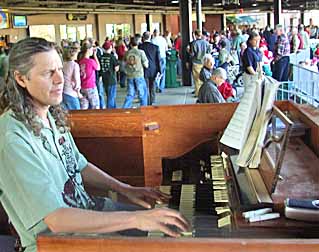 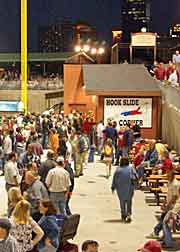 |
Second, since it would be totally illogical to throw away three-quarters of a century of history from Ray Winder, the three plaques from the area just inside the main gate at the old park are prominently displayed at the new one. These plaques honor Max Moses, the Travs’ president from 1965 until 1980, Jim Elder, the team’s broadcaster for 34 seasons, and Ray Winder himself. I assume that a plaque for long-time team GM Bill Valentine (see below) won’t be too far in the future.
Third, another legendary individual from Ray Winder is also honored at Dickey-Stephens. Walter Bradshaw, now deceased, was probably the Travelers’ most famous fan. He was better known by his nickname, “Hook Slide,” because of his signature slides down the third-base line. The beer garden down the first-base line in the new park is named the Hook Slide Corner (above right).
Fourth, a wonderful tradition is also being continued. Talented play-by-play man Phil Elson channels Harry Caray by leading the crowd in singing Take Me Out To The Ball Game during the seventh-inning stretch (below right). Not only is he great at calling the action on the radio, he has a nice singing voice … certainly better than Caray!
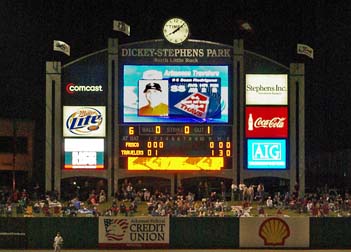 |
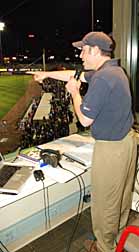 |
Fifth, I’d always thought the prices of tickets and concessions at Ray Winder were extremely reasonable, and I’m delighted to report that you can still bring a family to a Travs game — and feed them — without breaking the bank. If you pay to park, it’s $3 in the lot across the street (note that you can also take the River Rail Trolley line to the park, so you don’t have to drive). Tickets range from $6 for general admission (only $3 for kids) to $8 for reserved seats and $10 for the best box seats. Higher, yes, than at Ray Winder, but still quite reasonable. The excellent food prices include $4 for a wonderful BBQ sandwich, $2.75 for a so-so brat, $2.50 for a hot dog and $1.75 for either popcorn or peanuts. Drinks are very affordable, too: $2.50 for a medium soda; $1.75 for bottled water; $2.75 for domestic draft beers; $3.25 for imports and $4.00 for a glass of wine. These are among the lowest concession prices in pro baseball.
Sixth, and perhaps most importantly, the devoted fans of the Travelers have made the trip across the river to follow their favorite team. They create a fun environment.
Yes, the game-day experience at Dickey-Stephens combines the best elements of an evening at Ray Winder with all of the modern comforts that the old place was never going to provide. On opening night, fans were walking around with eyes wide, marveling at all that the team’s new home has to offer.
By the way, the quality of the sound in the park is excellent, as there are about 80 speakers scattered around the facility. The info conveyed on the scoreboard (above left) is also more than sufficient, especially with its 18′ by 32′ high-resolution video board. The overall scoreboard cost $1.2 million, I should add, and when it looked like it was going to push the project too far over-budget, Warren Stephens (who donated the land for the park, remember) chipped in $423,000 to complete the board.
I was surprised, though, that there is no playground for youngsters, like the excellent play areas at the new parks in Greensboro, Manchester, Ogden and both Midlands (Texas and Michigan). However, Dan Phillips of HKS let me know that the city’s mayor, Patrick Hays, has “designated the small empty lot down the left field line as a kids park that the city of North Little Rock will be building in the near future.” Glad to hear it, since it was one of the few ways in which Dickey-Stephens is deficient. In the meantime, there is a large open area (below left) well beyond the right-field berm where kids of all ages can play catch and run around burning up energy. Good idea, although I wonder if this is permanent, since early site plans showed additional development between the ballpark and river, and condos or a hotel could end up on part of this open area.
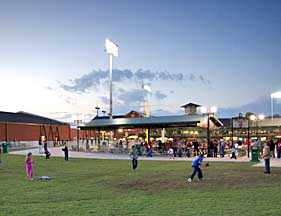 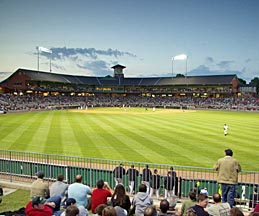 |
So from the reasonable prices to the great view to the wonderful sound quality, all of the elements for a positive experience are in place. Kudos to the team, to the city of North Little Rock, to HKS and to the fans!
Summary
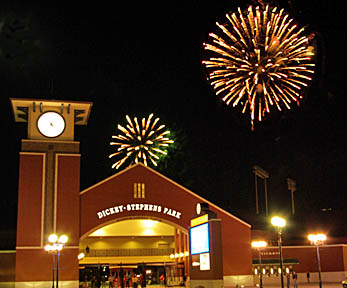 |
Since attending opening night, I’ve been keeping an eye on the newspapers in Arkansas and on blogs and sites that have provided feedback on the new park. It’s no great surprise that the locals are happy with the place, but I’ve also detected an enormous amount of pride that such a great facility has appeared in their state. In this regard, it reminds me of the opening of Appalachian Power Park in my home state of West Virginia. Both states are somewhat maligned by many illuminati around the country, and the opening of a first-class sports facility made the locals justifiably proud.
“It was bitter-sweet in a way moving from Ray Winder into a new park, since the old park had so much history to it,” Paul Allen, the Travs’ Director of Group Sales, told me. “Our fans were a little skeptical at first, but I do think they expected the new park to be nice. They just didn’t expect it to be this nice! The fans were really in awe of the place once we started playing games in it.”
The man largely responsible for filling so many hearts in central Arkansas with happiness, pride and awe is Bill Valentine. He deserves a great deal of the credit for the look and feel of Dickey-Stephens Park. This remarkable man was an American League umpire for six seasons in the 1960s. He then was the general manager of the Travelers for three decades, until being named Executive VP and Chief Operating Officer of the team early in 2007.
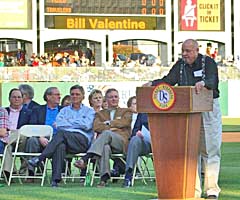 |
And before all of that, he graduated from North Little Rock High School in 1950. No wonder tears of joy streamed down his cheeks that night in 2005 when NLR’s voters passed the sales-tax increase to fund the construction of a new ballpark.
Bill (wearing his signature suspenders while speaking at the podium in the photo to the right) was tireless in his oversight of the design of the park, and he is justifiably thrilled with how it turned out. “I don’t mind saying we’re proud of what we’ve accomplished here,” he wrote in a guest column for a special publication on the ballpark created by Central Arkansas Newspapers. “But that’s because we truly believe this park is a great thing — for baseball and for Arkansas.” And isn’t it fitting that this grand, new ballpark with its clever railroad theme is the brainchild of the son of William Valentine, Sr., a railroad worker, and is named for the Dickey brothers, whose father also made his living workin’ on the railroad, all the live-long day?
By moving across the river, the Travelers have not only changed addresses and cities, they’ve also moved to a different ballpark galaxy. While 75-year-old Ray Winder Field had unlimited charm and a sense of history, it lagged far, far behind the pack in meeting the standards of today’s modern baseball facilities. With Dickey-Stephens Park — with its hints of PNC Park and Busch Stadium — Arkansas now has the rest of the Minor-League-ballpark landscape in its rear view mirror.
Bill Valentine also had the quote of the day right before the first game was played in Dickey-Stephens Park. In wrapping up his remarks during the opening ceremonies, Bill quipped, “If you build it, they shall come. We did. You did. Let’s play ball!